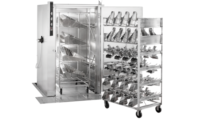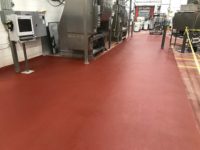When it comes to facility and equipment sanitation requirements, there is no “one size fits all” approach that will cover the needs of the varying products, processes and equipment we see across the snack and bakery industry. Different products and lines will dictate the best approach, which can include wet and/or dry cleaning procedures are part of an operator’s Sanitation Standard Operating Procedures (SSOPs).
“Washdown vs. dry cleaning will be debated for years to come with different factions leaning one-way or the other—or both,” says Jeff Dearduff, corporate director, baking and snack, The Austin Company, Cleveland. “Design of a facility will require this topic to be considered in the early stages. Every producer will have different ideas on how to handle this.”
Microorganisms need a wet environment to live, notes Darrin McCormies, senior vice president, director of industrial process engineering, Epstein, Chicago. “Where possible, the design of the process and production space should strive to be able to be dry cleaned.” He notes that using compressed air to remove material from equipment has fallen out of favor. “Employing vacuums to remove material is preferred.” All too often, using compressed simply transports the material to another location where it could cause problems.
“A common remark is ‘water is the enemy’ in the production area of the bakery,” says John Koury, architect and consultant to A M King, Charlotte, NC. “Dry sanitation is much preferred, extending to omitting floor drains in these areas, which may be counterintuitive to designers without bakery experience.”
Areas that are destined for dry sanitation procedures require special design considerations. “Where dry cleaning is a must, smooth floors, centralized vacuums and some compressed air are all required to make the cleaning process efficient,” says Dearduff.
“Dry-clean environments must have the proper level of non-skid/coefficient of friction to facilitate easy and simple sanitation,” says Dan Koehler, vice president, Indue Sales & Services, Inc., Hudson WI. “An extremely aggressive finish that traps and holds dirt/debris is not ideal in such an environment. Whenever possible—and only if dry-cleaning applications are sufficient to maintain a sanitary, hygienic environment—avoid introducing water to a process that does not already utilize it. Introducing water to the sanitation and cleaning process may create bigger sanitation issues than a suitable dry cleaning regimen.”
Nevertheless, some bakeries find that they still require washdown for some processes and equipment. “Where wet washdown is a must, such as in a mixing room, proper flooring, base coving, drains, sloping, wall finishes and curbing can be easily and effectively designed for the space,” says Dearduff.
McCormies notes that for areas that must be wet-washed, special attention must be paid to controlling the water:
- Floors must be sloped to drains and without low points where puddles can form
- Walls, ceilings, the overall structure and equipment must be constructed of non-corrosive materials
- Concrete slabs and wall curbs should be coated to prevent corrosion of the concrete, to eliminate the risk of cracks in the concrete and to provide a non-slip surface
- If hoses are used, they should not use nozzles or high pressure, as high-velocity washdown can create airborne water droplets that spread contamination
- HVAC systems should be designed to quickly ventilate and dry out the air after the washdown is compete
“For washdown areas, it is critical to choose the appropriate level of non-skid/coefficient of friction to preserve worker safety and prevent slips or falls,” says Koehler. “Drain placement and type is very important for wet-wash areas, as drains can be a critical sanitation point where microbes flourish if not designed or cleaned properly. Ensuring a proper floor slope/pitch exists in these areas is also of utmost importance.” He recommends 1/8-inch per foot at the minimum.
“Additionally, temperature fluctuations from high-temp washdowns and harsh sanitation chemicals must be taken into consideration, affecting the recommended coating system based on its chemical resistance, thermal shock strength, and its ability with withstand repetitive and deleterious sanitation cycles,” says Koehler.
Some snack and bakery facilities opt to use an isolated room for washdown. “If it is a matter of removable equipment requiring washdown, an isolated cleaning room is preferable to keep water localized,” says Tyler Cundiff, director of business development, Gray Construction, Lexington, KY. “In the case of immovable equipment, such as a mixer, easily accessible drains with sloped floors is the preference.”
A third option is available for some situations. “Steam cleaning is getting some publicity these days with the newer portable and ‘dry’ steam processes that are available. Special tools can be used for different production equipment of building systems,” says Dearduff. “The bottom line to all of these methods is their effectiveness. With the requirements of environmental swabbing and testing these days, getting the cleaning done right the first time is critical. Cleaning twice is costly.”
For more insights into sanitary facility design, see “Sanitary design best practices for snack and bakery facility construction.”





